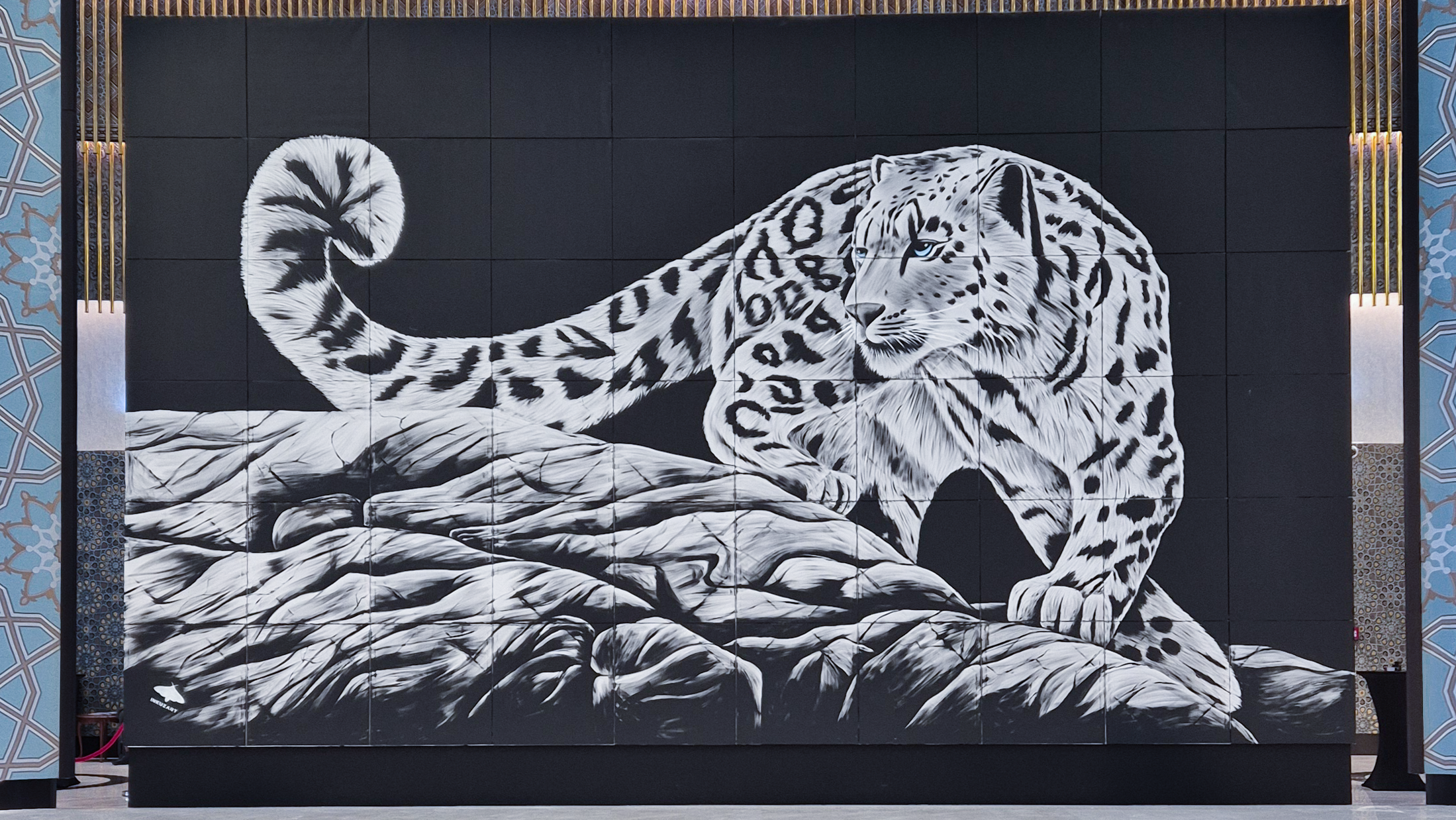The Convention on the Conservation of Migratory Species of Wild Animals (CMS) has stood steadfast as a pivotal intergovernmental partner to the East Asian-Australasian Flyway Partnership (EAAFP) since our inception. United in purpose, we have advocated for initiatives such as the promotion of World Migratory Bird Day and the formulation of Species Action Plans tailored to address the plight of endangered species, notably including the Black-faced Spoonbill (EN), Spoon-billed Sandpiper (CR), Chinese Crested Tern (CR), Baer’s Pochard (CR), and Dalmatian Pelican (NT).
From February 9th to 19th 2024, the Fourteenth Meeting of the Conference of the Parties to the Convention on the Conservation of Migratory Species of Wild Animals (CMS COP14) convened in Samarkand, Uzbekistan. This significant event attracted over 1,700 participants, including representatives from 92 parties, 16 United Nations agencies, and more than 240 individuals from various conservation organisations worldwide. Partners from EAAFP who attended CMS COP14 are:
- National governments: Mongolia, the Philippines, Bangladesh, Australia, and New Zealand
- Intergovernmental organisations: ASEAN Centre For Biodiversity (ACB), Convention on Biological Diversity (CBD), Convention on Migratory Species (CMS), Convention on Wetlands
- International non-governmental organisations: BirdLife International, Hanns Seidel Foundation–Korea, International Crane Foundation (ICF), Wildlife Conservation Society (WCS), World Wildlife Fund for Nature (WWF)-Hong Kong
- International organisation: International Union for Conservation of Nature (IUCN)
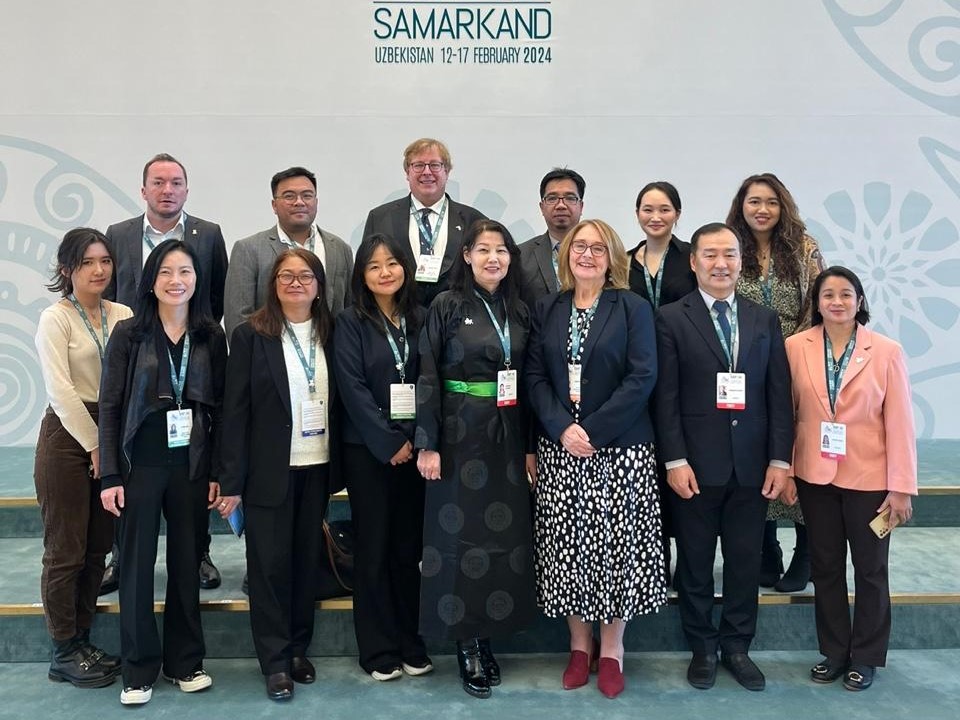 Say cheese! Photo with some of EAAFP’s Partners on Day 1 © EAAFP
Say cheese! Photo with some of EAAFP’s Partners on Day 1 © EAAFP
Top row (left to right): Felix Glenk, James Santiago, Bernhard Seliger, Anson Tagtag, Bayarmaa Chuluunbat, Kyle Esperanza Zuleta
Bottom row (left to right): Shakhrizoda Islomova, Hyun-ah Choi, Clarissa Arisa, Minjae Baek, Uranchimeg Tserendorj, Jennifer George, Nyambayar Batbayar, Katherine Soriano
Throughout CMS COP14, 52 agenda items spanning 25 thematic groups were deliberated, covering crosscutting, terrestrial, avian, and aquatic concerns. Among these items, several were particularly pertinent to the endeavours of the EAAFP.
Key outcomes of COP14 with relevance to EAAFP were:
Migratory Birds
- Agreement on an Initiative for the Central Asian Flyway, which spans 30 Range States, after nearly two decades of inconclusive negotiations. The adopted initiative includes the establishment of a coordinating unit in India with financial support from the Government. (UNEP/CMS/COP14/CRP28.4.2/Rev.1)
- A new approach agreed to global flyways coordination under the CMS umbrella for CMS and non-CMS parties and partners.
- Expansion and reinforcement of the prevention of illegal killing, taking, and trade of migratory birds with a call for strengthening the recently created Asia-Pacific Intergovernmental Task Force and agreement on the launch of a new Task Force in Southwest Asia, based on the successful model of the Task Force in the Mediterranean region. (UNEP/CMS/COP14/Doc.28.1/Rev.1)
Cross-cutting issues
- Strengthened resolution on climate change and endorsement of the report on the climate change on migratory wildlife. (UNEP/CMS/COP14/CRP30.4.1/Rev.1)
- Strengthened measures to address the illegal and unsustainable taking of migratory species. (UNEP/CMS/COP14/CRP30.1.1/Rev.2)
- Actions to advance ecological connectivity. (UNEP/CMS/COP14/Doc.30.2.1.1 and UNEP/CMS/COP14/Doc.30.2.1.2)
- New global guidelines addressing the impacts of light pollution on migratory species. (UNEP/CMS/COP14/Doc.30.4.4)
- Recommendations on addressing linear infrastructure development and impact assessment. (UNEP/CMS/COP14/CRP30.3.1)
- Endorsement of a new scientific report “Insect Decline and its Threat to Migratory Insectivorous Animal Populations”, and a call for the CMS Scientific Council to develop new guidelines. (UNEP/CMS/COP14/CRP30.4.2)
- Adoption of a new decision on Wildlife Health encouraging CMS Parties to implement the recommendations of the scientific report ‘Migratory Species and Health: A Review of Migration and Wildlife Disease Dynamics, and the Health of Migratory Species, within the Context of One Health’ also endorsed by the COP. (UNEP/CMS/COP14/CRP30.4.3)
- A new, science-based Samarkand Strategic Plan for Migratory Species for the period 2024-2032. (UNEP/CMS/COP14/Doc.14.2)
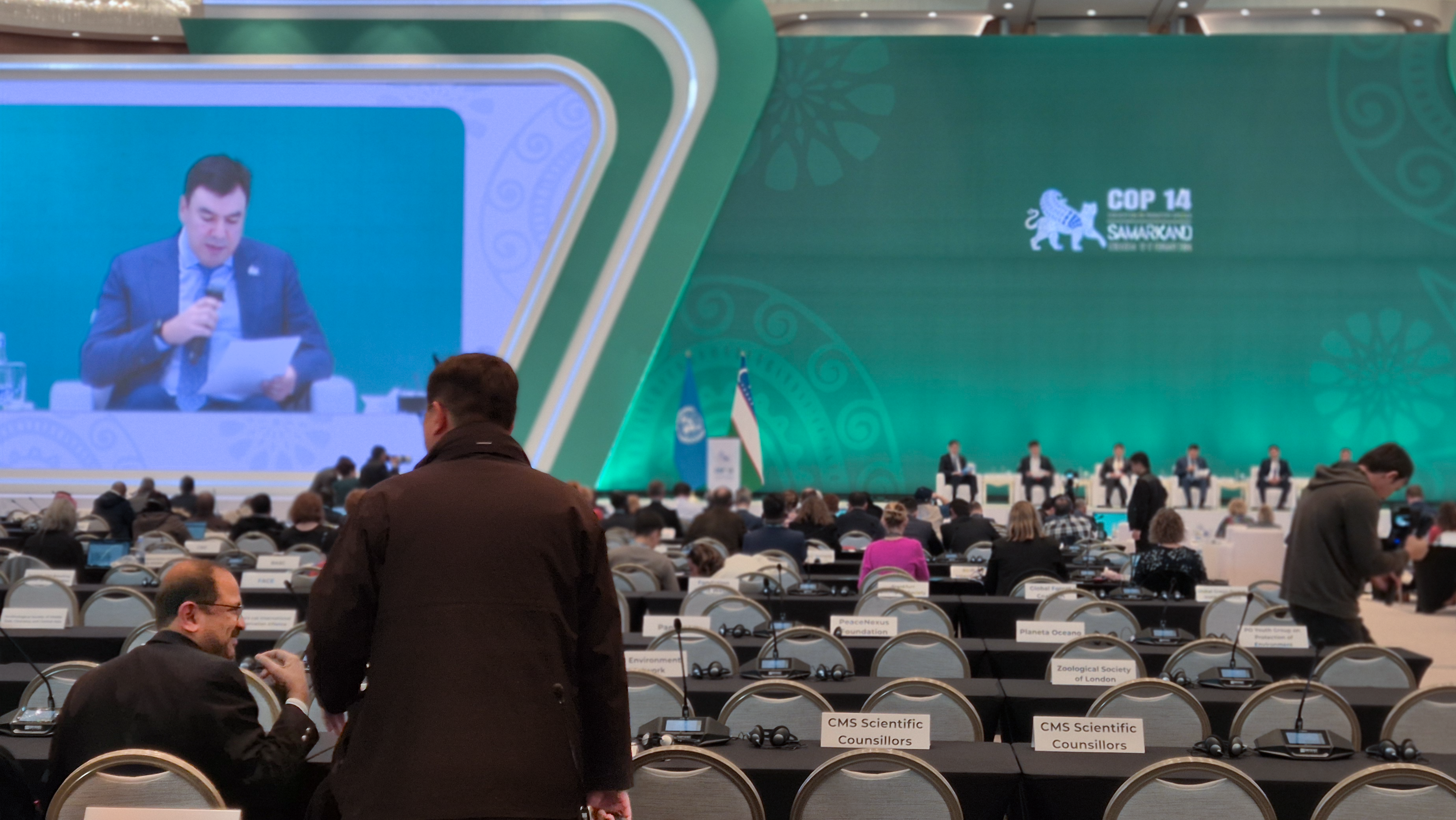 During the CMS High-Level Segment Session 1, a panel of Central Asian officials, including Aziz Abdukhakimov, Minister of Ecology, Environmental Protection, and Climate Change from Uzbekistan (on screen), engaged in a discussion. © EAAFP
During the CMS High-Level Segment Session 1, a panel of Central Asian officials, including Aziz Abdukhakimov, Minister of Ecology, Environmental Protection, and Climate Change from Uzbekistan (on screen), engaged in a discussion. © EAAFP
High-level Segment
Preceding the official opening of COP14 on February 12th, a High-level Segment was held on February 11th, focusing on the theme “Nature Knows No Borders: Working together for migratory species and sustainable development in Central Asia.” This segment reinforced the commitment to transboundary cooperation for the conservation of migratory species, highlighting the imperative of collaborative efforts in ensuring their protection and sustainable development.
Among the distinguished speakers at the High-level Segment of CMS COP14 stood the Philippines. Represented by H.E. Mr. Ernesto D. Adobo Jr. Undersecretary of the Department of Environment and Natural Resources, the Philippines highlighted its extensive efforts and initiatives in migratory species conservation at national, regional, and global levels. H.E. Adobo also announced the Philippines’ hosting of the 12th Meeting of Partners (MoP12) of the EAAFP and pledged to designate 20 Flyway Network Sites.
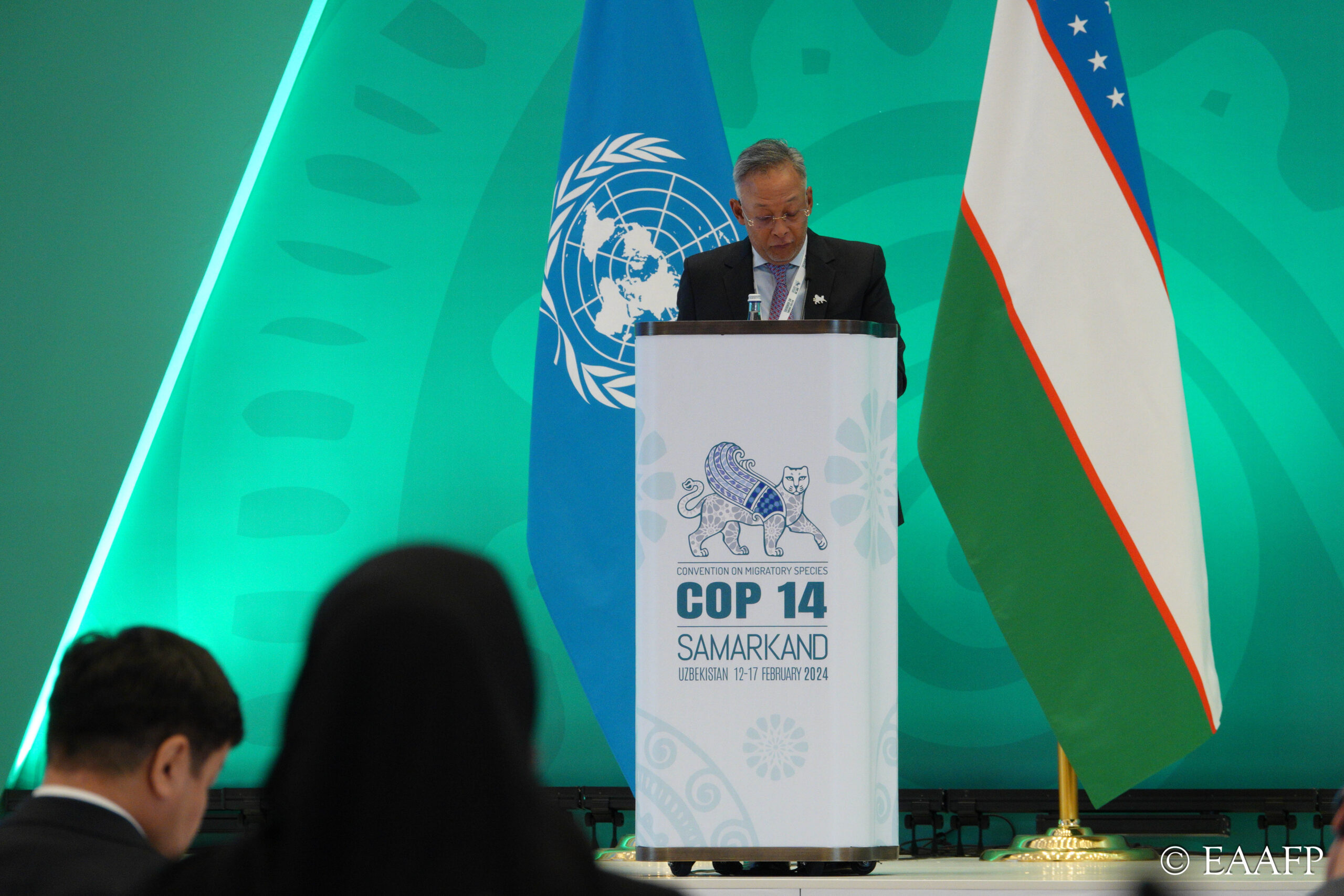 Ernesto. D. Adobo Jr., Department of Environment and Natural Resources, delivering the Philippines’ intervention at the CMS High-level Segment. © EAAFP
Ernesto. D. Adobo Jr., Department of Environment and Natural Resources, delivering the Philippines’ intervention at the CMS High-level Segment. © EAAFP
The Committee of the Whole (Plenary)
Amidst the grand inauguration of the fourteenth meeting of the Conference of the Parties (COP14) to the Convention on the Conservation of Migratory Species of Wild Animals (CMS) on Monday, attendees were welcomed with opening remarks. Among these, Abdulla Aripov, Prime Minister of Uzbekistan, underscored the imperative for “urgent and coordinated” actions needed to “preserve the harmony of human life with nature.”
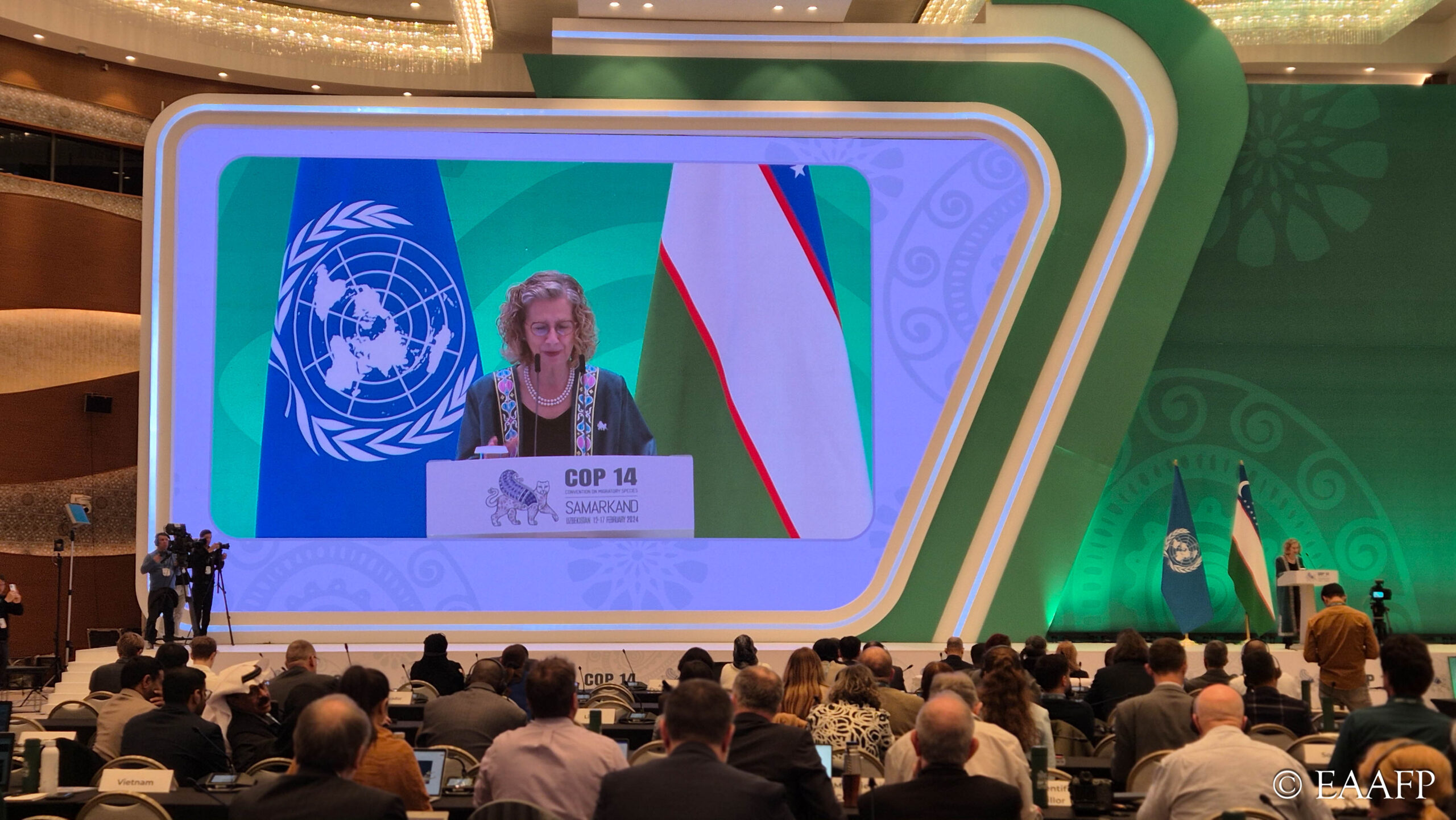 Among the opening remarks, Inger Andersen, UN Under-Secretary-General and Executive Director of the UN Environment Programme (UNEP), called upon all countries to safeguard crucial species and ecosystems. © EAAFP
Among the opening remarks, Inger Andersen, UN Under-Secretary-General and Executive Director of the UN Environment Programme (UNEP), called upon all countries to safeguard crucial species and ecosystems. © EAAFP
Throughout the plenary sessions, EAAFP Partners and the Secretariat delivered multiple interventions on key agenda items and conveyed messages pertinent to the conservation of migratory birds.
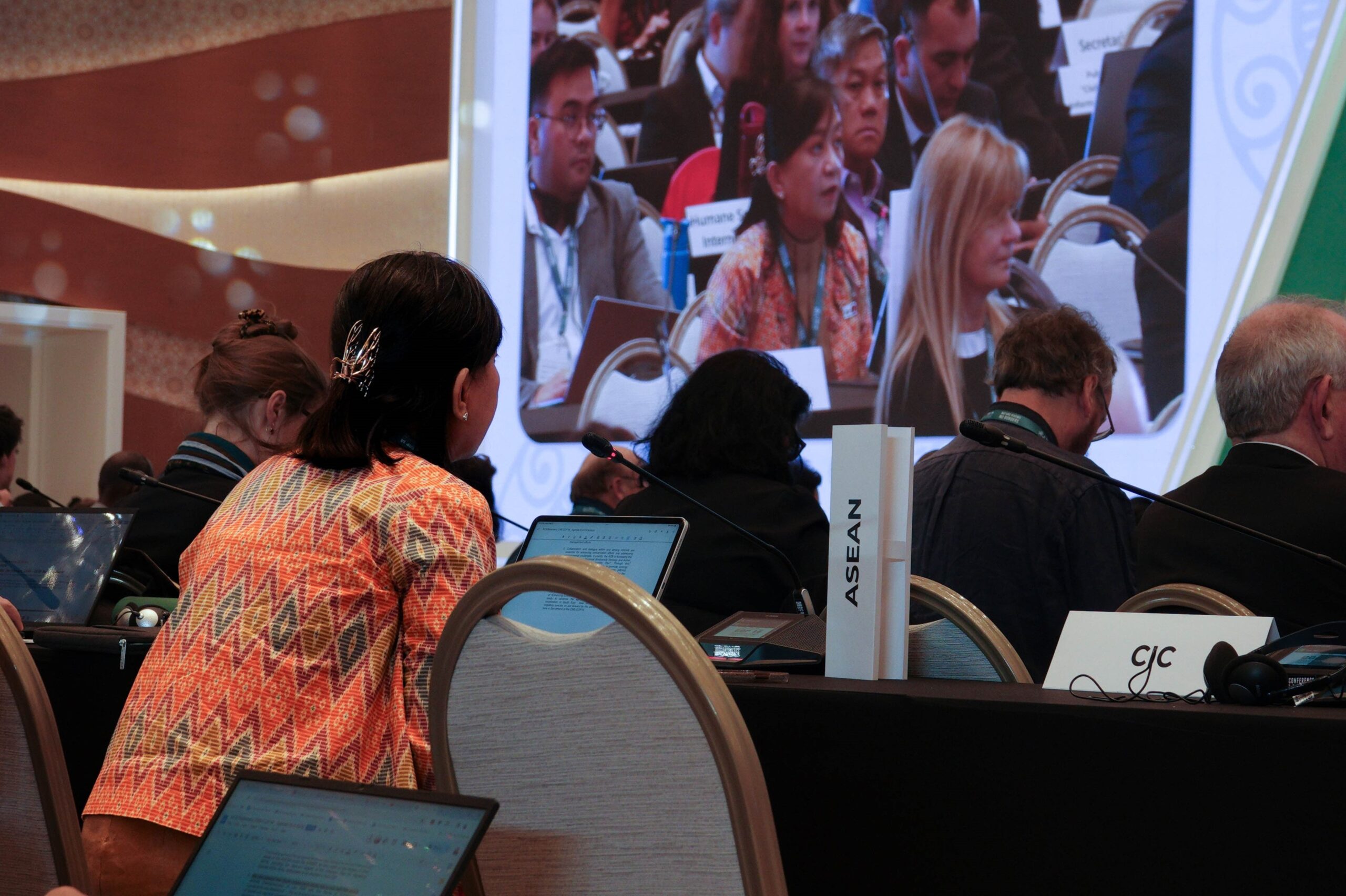 Theresa Mundita S. Lim, ASEAN Centre of Biodiversity, acknowledged in an intervention the interconnectedness of wildlife resources across terrestrial and marine ecosystems, stressing the need for robust cross-sectoral and transboundary cooperation. © EAAFP
Theresa Mundita S. Lim, ASEAN Centre of Biodiversity, acknowledged in an intervention the interconnectedness of wildlife resources across terrestrial and marine ecosystems, stressing the need for robust cross-sectoral and transboundary cooperation. © EAAFP
On our end, Chief Executive, Jennifer George, made the following intervention on the ‘Initiative for Central Asian Flyway’ resolution:
“This intervention is made by the East Asian-Australasian Flyway Partnership. We are a voluntary international partnership with 18 government partners. The CAF (Central Asian Flyway) is an integral part of our World Global Flyway network. Many of our partners have provided support for the development of the formal establishment of this flyway. So, we share countries and species at the margins of our flyways, and our partnership will continue to offer support for the management, operation, and development of this flyway in Central Asia. Thank you.”
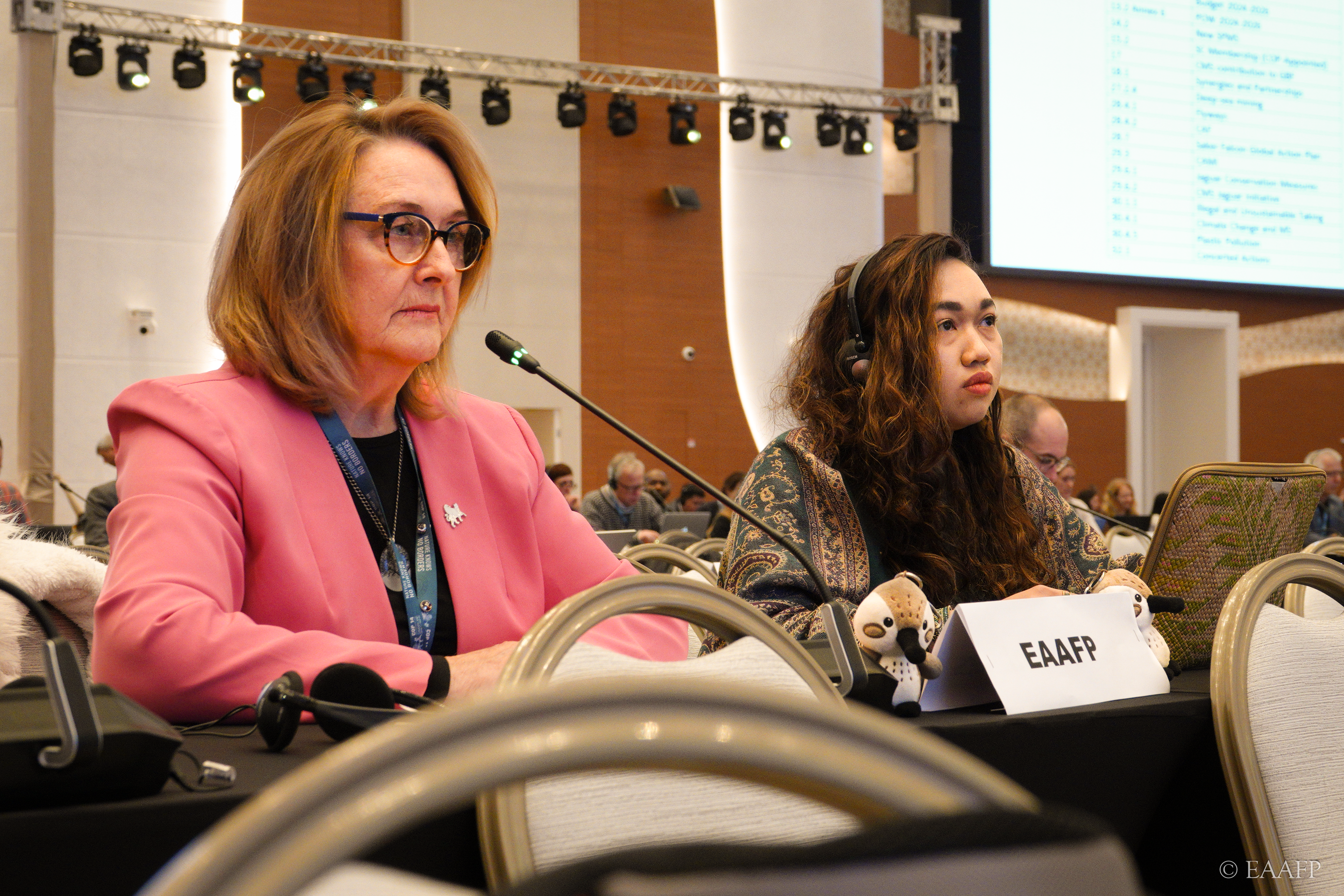 During her intervention, Jennifer George emphasised EAAFP’s dedication to promoting international collaboration in protecting migratory birds and their habitats across borders. © EAAFP
During her intervention, Jennifer George emphasised EAAFP’s dedication to promoting international collaboration in protecting migratory birds and their habitats across borders. © EAAFP
Pre-, Side & Special Events
During CMS COP14, the EAAFP Secretariat facilitated numerous activities aimed not only at promoting dialogue, but also to promote Partners’ involvement in a range of side events occurring between and after the plenary sessions. It was during these aforementioned side events that party states, non-governmental organizations, and intergovernmental bodies delved into discussions covering vital topics concerning migratory species, including ecological connectivity, climate change, illegal hunting, and renewable energy, engaging stakeholders from various sectors.
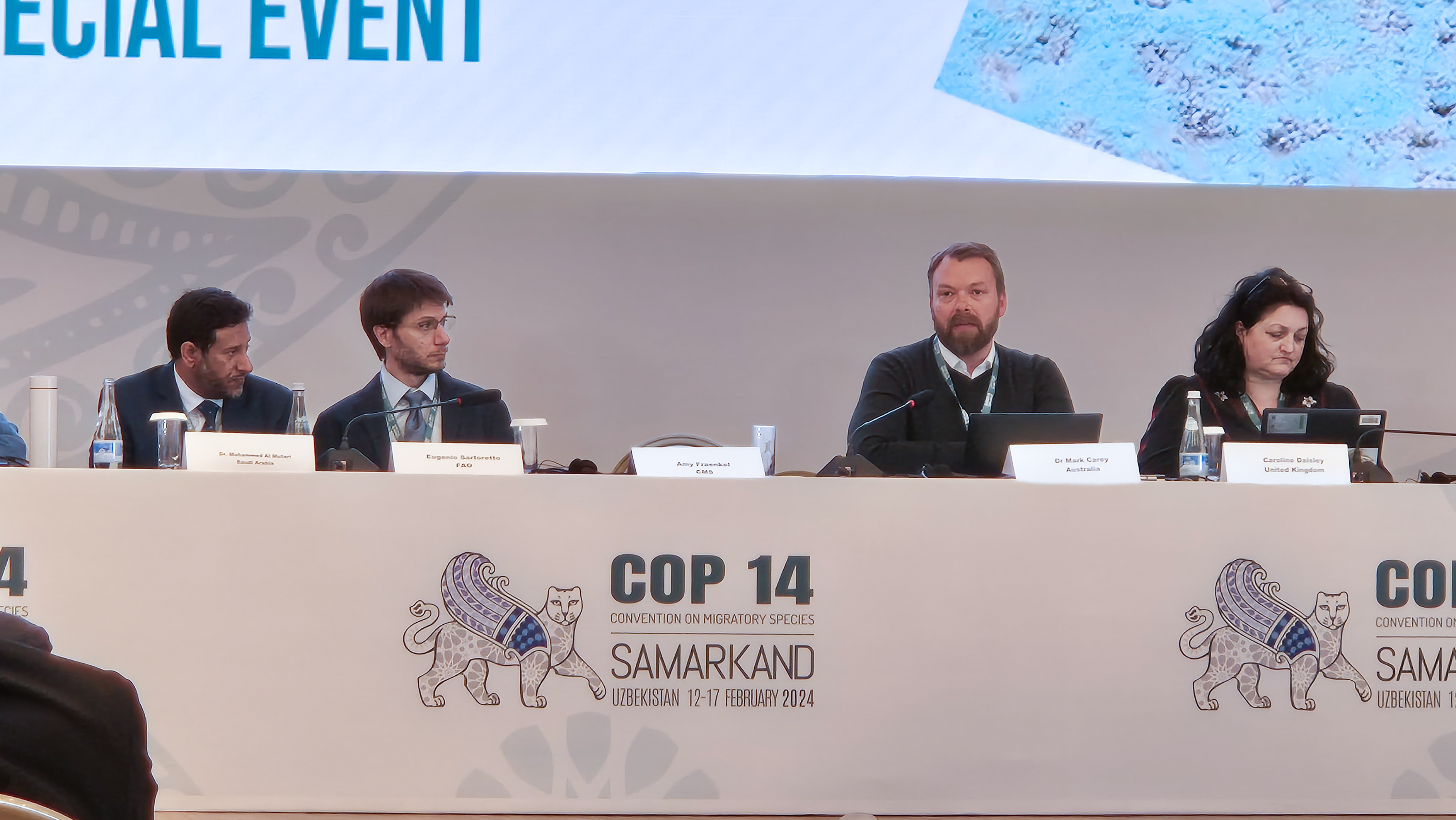 Mark Carey, Australia, expressing support for ITTEA during the Special Event titled “Dialogue and Consultation on a New Initiative on Illegal and Unsustainable Taking of Migratory Species” © EAAFP
Mark Carey, Australia, expressing support for ITTEA during the Special Event titled “Dialogue and Consultation on a New Initiative on Illegal and Unsustainable Taking of Migratory Species” © EAAFP
In total, EAAFP’s Partners (highlighted in bold) participated in over 20 side events (unless stated otherwise), which included:
10th February:
- [Pre-Event] “Inter-Flyways Workshop” by Hanns Seidel Foundation–Korea (HSF–Korea) (view more here: 1, 2, 3, 4, 5, 6, 7, 8, 9, 10, 11, 12, 13, 14, 15, 16) — Secretariat invited as speaker
12th February:
- Harmonizing Ecosystem-Based Adaptation and Climate-Smart Conservation in Central Asia by UNEP, CMS
- Mainstreaming Ecological Connectivity to Support the Protection of Migratory Species: Strengthening Local and Subnational Initiatives by ICLEI – Local Governments for Sustainability (view more here: 1, 2) — Secretariat invited as speaker
- Human and Animal Culture as Determinants of Spatial Units for Species Conservation Action by IUCN, CMS
- Mobilising Sustainable Resources for Wildlife Conservation: Opportunities and Strategies by IUCN, UNEP
- Single Species Action Plans (SSAPs): An Effective Tool for Flyway-Wide Conservation of Threatened Migratory Birds by AEWA, CMS, Raptors MOU, BirdLife International, Uzbekistan’s Society for the Protection of Birds (view more here)
13th February:
- Securing Asian Flyways: Ecological Perspective, Knowledge Sharing and Management by ICF, HSF–Korea, IUCN (view more here: 1, 2, 3)
- Planning Energy Infrastructure in Uzbekistan with Migratory Birds in Mind by BirdLife International, DEG Impulse GMBH
- [Special Event] Climate Change and Migratory Species Report by CMS, JNCC, DEFRA, UK, BTO
- Disrupted Planet, Disrupted Health: The Health of Migratory Species with Avian Influenza Case Study by CMS, University of Edinburgh, UK (view more here: 1, 2)
- One Health: Prevention of Zoonotic Disease Through Protected and Conserved Areas by IUCN
- Action on Landbirds and Avian Wild Meat Across the African–Eurasian and Central Asian Range by CMS, BirdLife International, Swiss Ornithological Institute
14th February:
- Harnessing Innovative Technology and Solutions to Support Robust Implementation of the Global Biodiversity Framework Goals and Targets by IUCN
- Financing the Energy Transition: Role of International Financial Institutions in Ensuring a Nature-Safe Renewable Energy Transition by BirdLife International
- [Special Event] Global Initiative on Ecological Connectivity by CMS
- Global Illegal Taking of Birds by CMS, BirdLife International
- Raising Global Awareness for Migratory Birds: World Migratory Bird Day by EFTA, CMS, AEWA, EAAFP (view more here: 1, 2, 3, 4) — Secretariat also invited as speaker
- Considering Nature-Safe Energy Infrastructure Development: From a Regional to Global Approach by Leibniz Institute for Zoology and Wildlife Research, BirdLife International
- Unlocking the Future: Innovative Climate Change Modeling for Biodiversity Conservation in Northeast Afghanistan and Beyond into Central Asia by WCS
15th February:
- Marine Flyways: Advancing Coordinated Conservation Action for Threatened Migratory Seabirds by BirdLife International, New Zealand Government (view more here: 1, 2, 3)
- [Special Event] Dialogue and Consultation on a New Initiative on Illegal and Unsustainable Taking of Migratory Species by CMS (view more here)
- AEWA: Working Together to Conserve Migratory Waterbirds by AEWA Standing Committee
- IUCN Species Conservation Action: A Global Plan and Financing Mechanism to Support Implementation of CMS and the Global Biodiversity Framework by IUCN
- The IUCN Green List Supporting Conservation of Migratory Species Through Effective Networks of Protected Areas by IUCN
- The World Coastal Forum: An Update by BirdLife International (view more here: 1, 2, 3)
EAAFP Partners’ Dinner
Adjacent to the COP proceedings, the Secretariat of EAAFP also played host to a successful informal dinner with Partners. Attended by 32 representatives hailing from Australia, the Philippines, the Convention on Wetlands, the Convention on Biological Diversity, the Convention on Migratory Species, ASEAN Centre for Biodiversity, BirdLife International, Wetlands International, Hanns Seidel Foundation (Korea, Mongolia, Central Asia), WWF-Hong Kong, International Crane Foundation, Wildlife Conservation Society, and the EAAFP Secretariat, the dinner also saw the participation of non-partners such as UNEP/AEWA, Eco Foundation Global, and the Asian Development Bank.
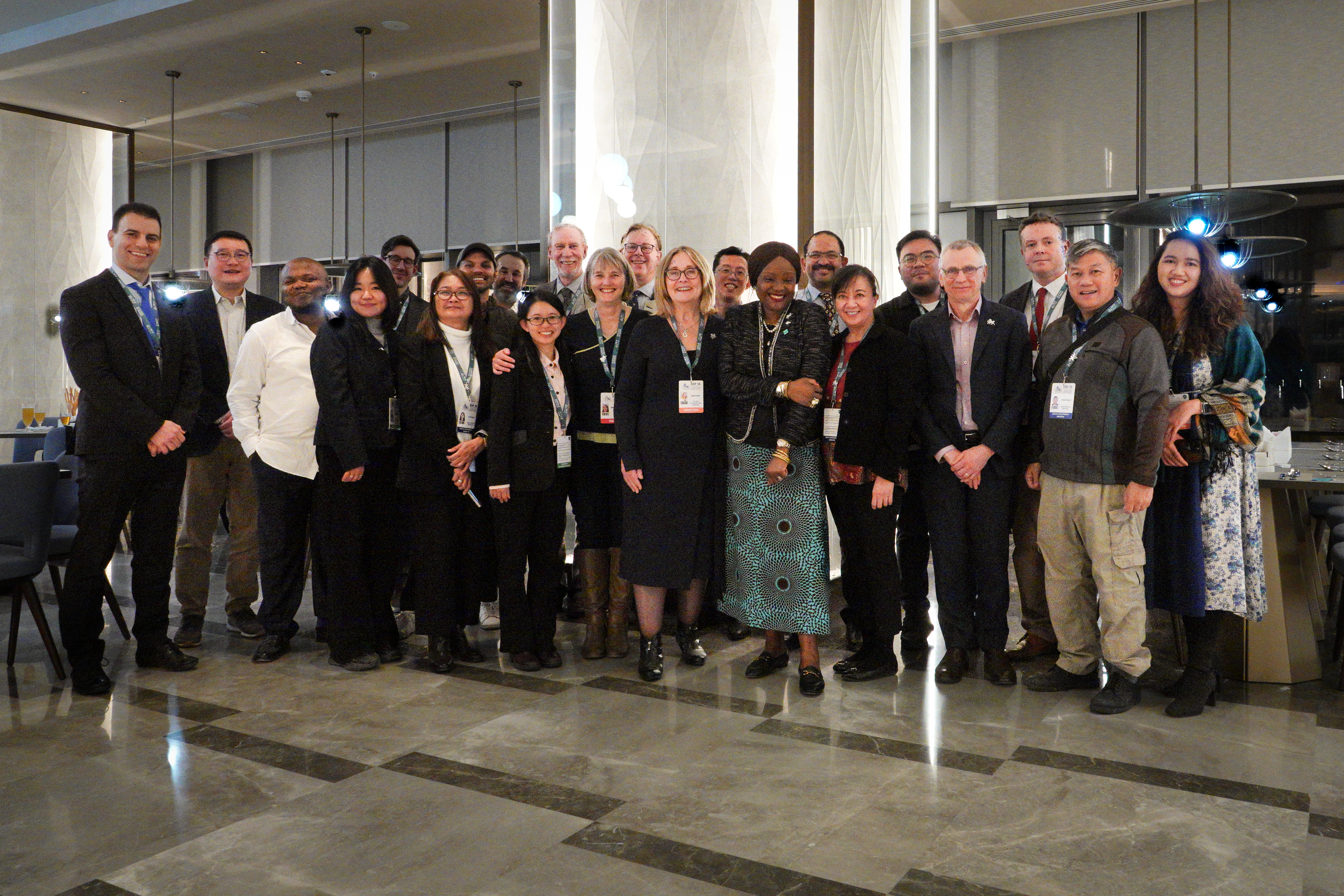 Front row (left to right): Iván Ramírez, Alex Zhang, Zebedee Feka Njisuh, Minjae Baek, Clarissa Arida, Vivian Fu, Narelle Montgomery, Jennifer George, Musonda Mumba, Theresa Mundita S. Lim, David Cooper, Sonny Lim
Front row (left to right): Iván Ramírez, Alex Zhang, Zebedee Feka Njisuh, Minjae Baek, Clarissa Arida, Vivian Fu, Narelle Montgomery, Jennifer George, Musonda Mumba, Theresa Mundita S. Lim, David Cooper, Sonny Lim
Back row (left to right): Sayam U. Chowdhury, Duncan Lang, Spike Millington, Bernhard Seliger, Ding Li Yong, Taej Mundkur, James Santiago, Florian Keil, Kyle Esperanza Zuleta © EAAFP
Gathering key stakeholders from various sectors and regions, the dinner not only sparked new connections but also fortified existing ones. Its significance extended beyond mere networking, acting as a cornerstone for fostering collaboration in safeguarding migratory species and their habitats.
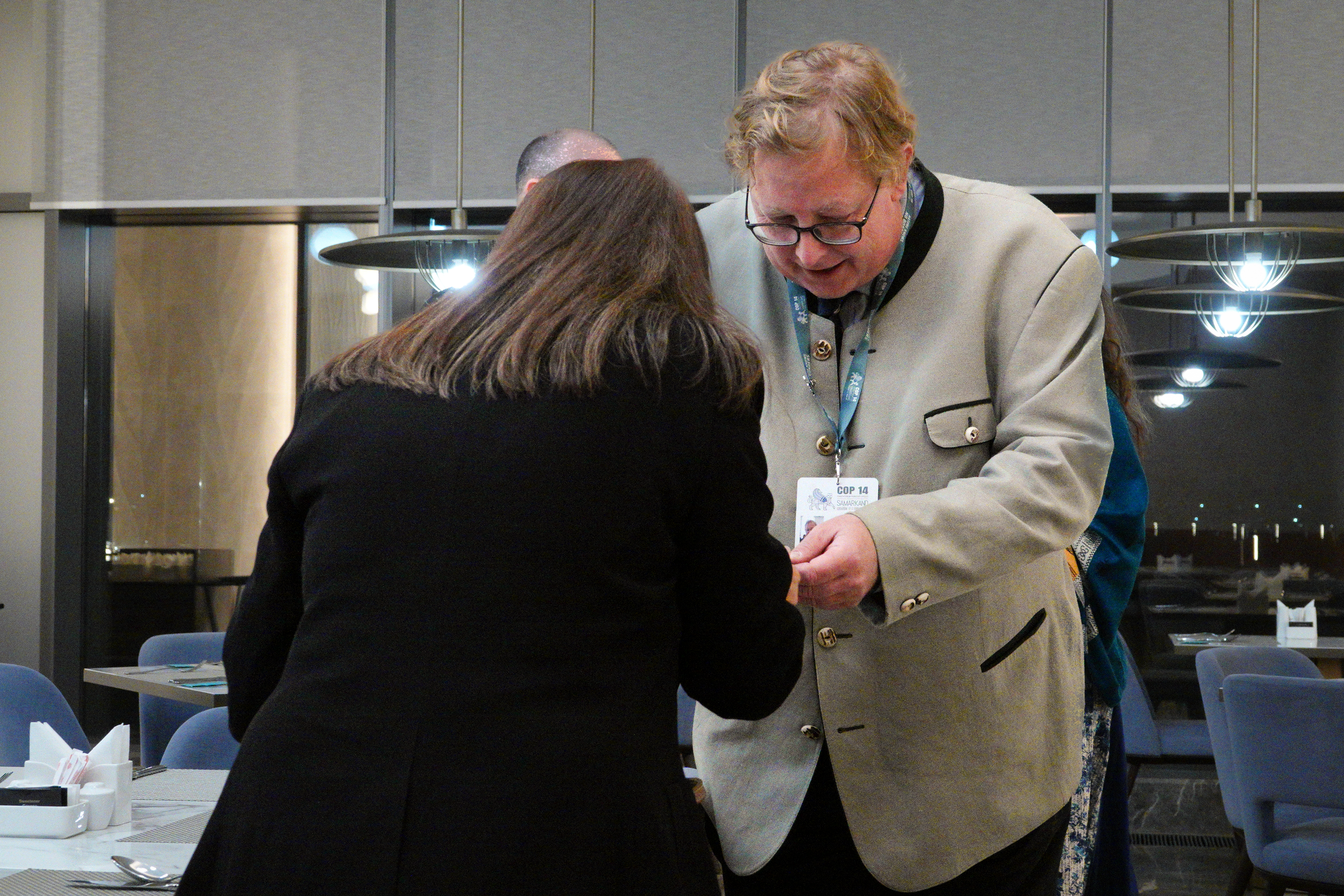 Clarissa Arida, ASEAN Centre for Biodiversity (left) and Bernhard Seliger, Hanns Seidel Foundation–Korea (right) © EAAFP
Clarissa Arida, ASEAN Centre for Biodiversity (left) and Bernhard Seliger, Hanns Seidel Foundation–Korea (right) © EAAFP
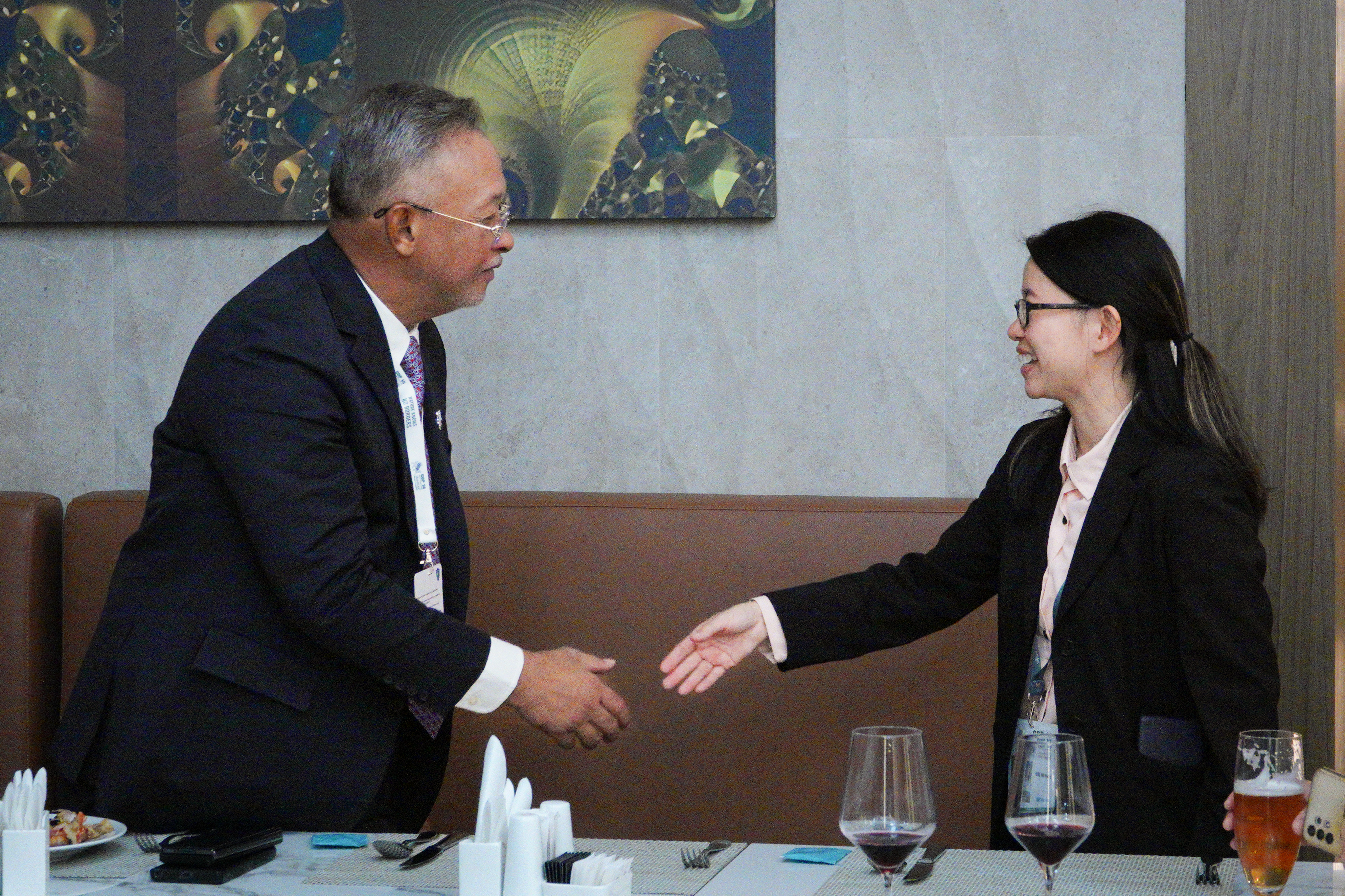 Ernesto D. Adobo Jr., Department of Environment and Natural Resources (left) and Vivian Fu, World Wildlife Fund for Nature (WWF)-Hong Kong (right) © EAAFP
Ernesto D. Adobo Jr., Department of Environment and Natural Resources (left) and Vivian Fu, World Wildlife Fund for Nature (WWF)-Hong Kong (right) © EAAFP
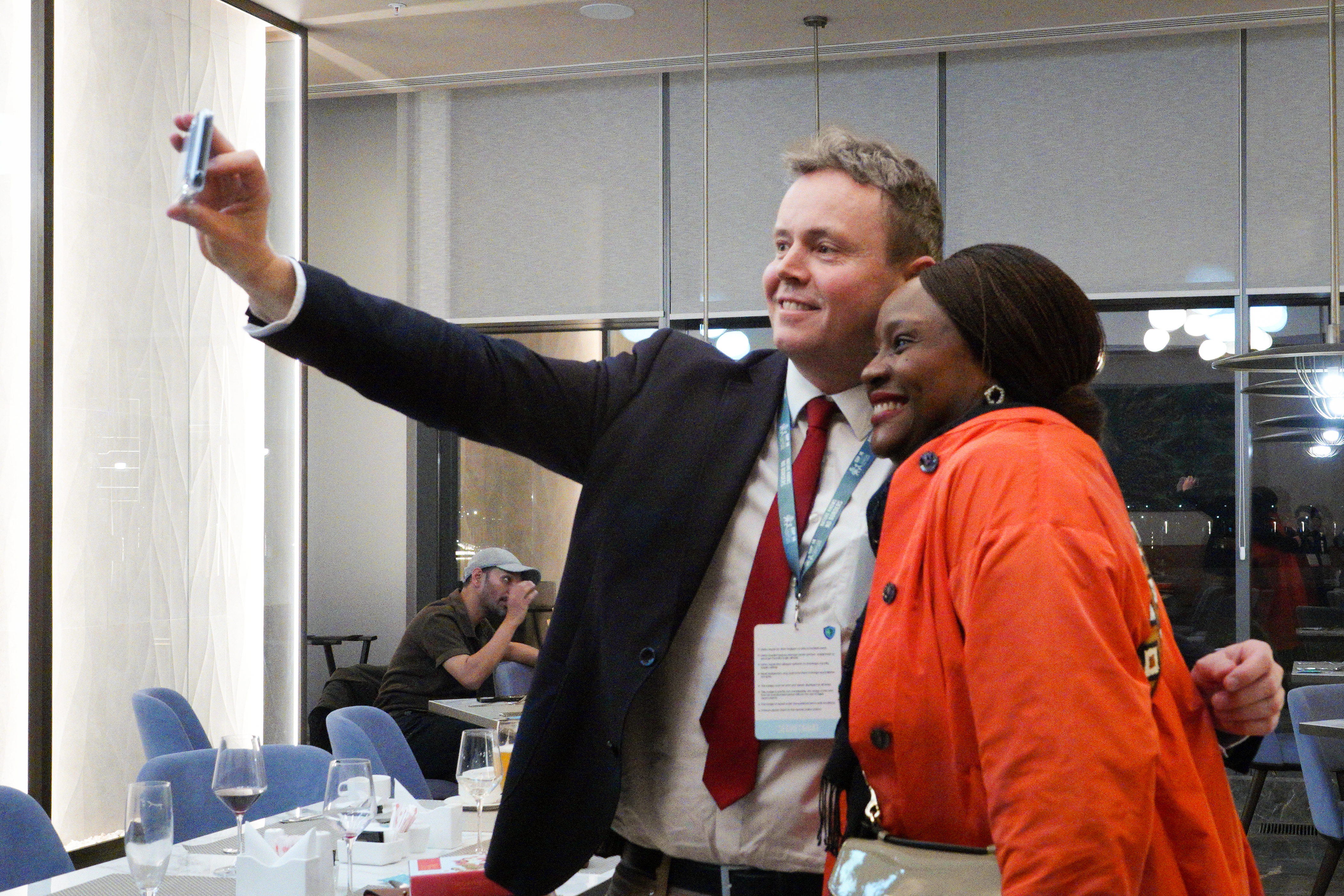 Florian Keil, United Nations (left) and Musonda Mumba, Convention on Wetlands (right) © EAAFP
Florian Keil, United Nations (left) and Musonda Mumba, Convention on Wetlands (right) © EAAFP
Summary:
From its inception, the reach of CMS COP14 has extended beyond political and geographical boundaries, mirroring the migratory species it seeks to safeguard. This session witnessed the addition of 25 new species, subspecies, and populations to CMS Appendices I and II, from the endearing Pallas’ Cat to the elusive Laulao Catfish. Altogether, six Memorandum of Understanding (MOU) signing ceremonies occurred, cementing agreements among various nations and institutions.
As newcomers to the COP scene, stepping in as part of the Secretariat evoked a mix of emotions. Still, amidst the nerves and excitement, we recognized its significance. This event not only provided us with the opportunity to delve into the complexities of the EAAFP’s role within Multilateral Environmental Agreements (MEAs), but it also shed light on the Secretariat’s crucial role in empowering our Partners and propelling the Partnership’s mission forward. So, here’s to making a positive impact together (and as a wise man once said, “Prioritise, prioritise, prioritise!”).
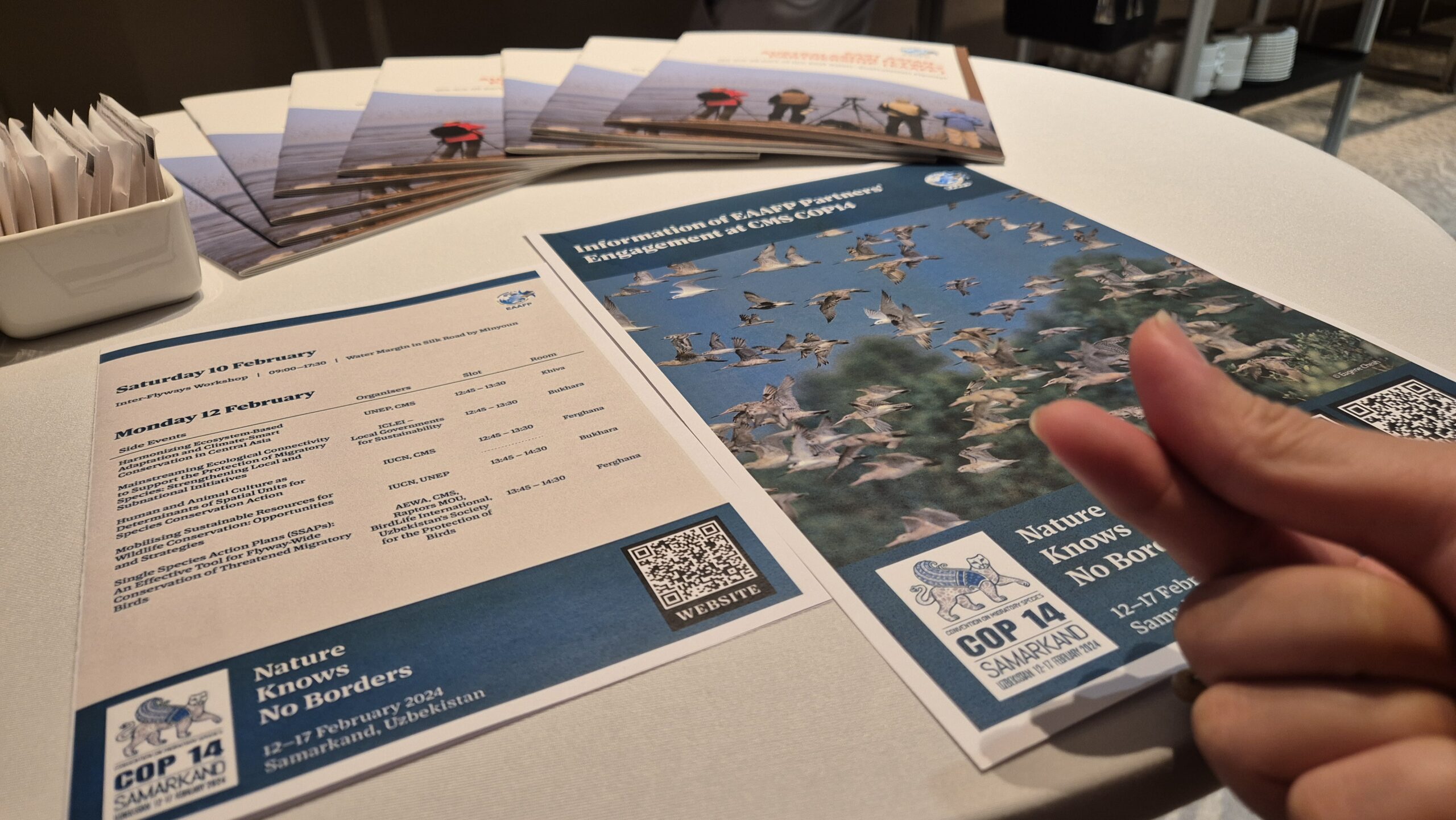 Uzbekistan, your hospitality was truly appreciated! © EAAFP
Uzbekistan, your hospitality was truly appreciated! © EAAFP
Other Information:
Use the following links to view additional photos taken by the Secretariat during that week on the EAAFP Flickr account.
Images for 10 February 2024
Images for 11 February 2024
Images for 12 February 2024
Images for 13 February 2024
Images for 14 February 2024
Images for 15 February 2024
Images for 16 February 2024
Images for 17 February 2024
Click below to explore a curated selection of Partner articles, official press releases, and news.
- CMS. (2024, 14 March). Historic UN Wildlife Meeting Concludes with Major Set of Actions for the Conservation of Migratory Species of Wild Animals [Press release]. https://www.cms.int/en/news/historic-un-wildlife-meeting-concludes-major-set-actions-conservation-migratory-species-wild
- International Institute for Sustainable Development. (2024, 21 February). CMS COP14 Reaches Beyond Borders to Protect Species and Ecosystems. SDG Knowledge Hub. https://sdg.iisd.org/news/cms-cop14-reaches-beyond-borders-to-protect-species-and-ecosystems/
- IUCN Save Our Species. (2024, 26 February). IUCN at COP14: Supporting Species Recovery to Achieve Global Biodiversity Goals. IUCN SOS. https://iucnsos.org/iucn-at-cop14-supporting-species-recovery-to-achieve-global-biodiversity-goals/
- Seliger, B. (2024, 20 February). Korea, Korean birds and the COP 14 of the Convention on Migratory Species (CMS). Birds Korea Blog. https://tinyurl.com/3z8c53an
- Summary of the Fourteenth Meeting of the Conference of the Parties to the Convention on the Conservation of Migratory Species of Wild Animals: 11-17 February 2024. (2024, 20 February). Earth Negotiations Bulletin, Volume 18 (No. 89), 1–17. https://enb.iisd.org/conference-parties-convention-migratory-species-wild-animals-cms-cop14-summary#recent-meetings-cop
- UN Environment Programme. (2024). Landmark UN report: The world’s migratory species of animals are in decline, and the global extinction risk is increasing [Press release]. https://www.unep.org/news-and-stories/press-release/landmark-un-report-worlds-migratory-species-animals-are-decline-and
- UN Environment Programme World Conservation Monitoring Centre. (2024). CMS COP14: Optimism for Migratory Animals, If the World Scales Up Action Now. UNEP–WCMC. https://www.unep-wcmc.org/en/news/cms-cop14-optimism-for-migratory-animals-if-the-world-scales-up-action-now

